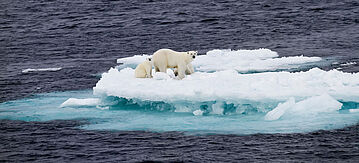Environmental changes

Environmental influences
Harmful environmental influences on the Arctic come from both global and local processes. Global environmental influences include greenhouse gas emissions, black carbon, ocean acidification, and cross-border pollution from chemicals and heavy metals, especially mercury. The loss of habitats for migratory species in other regions of the world also has negative effects on Arctic species and ecosystems.
At the local level, it is mainly the exploitation of natural resources, especially oil and gas production, fishing, shipping and tourism, which have an impact on the Arctic environment.
Climate change and its consequences
The consequences of climate change in the Arctic are already serious. The Arctic region is warming up three times as fast as the Earth's middle latitudes. This is because as the polar ice melts, the surface that reflects the sun's radiation into space gets smaller. Climate change can thus be seen first and most clearly here (the Arctic as "early warning system"). In recent years, the surface area of Arctic summer ice has decreased by an area four times the size of Germany. In the summer of 2012, the amount of Arctic sea ice was its lowest mark since systematic observation began.
Alongside the accompanying risks, including rising sea levels and the release of greenhouse gases when permafrost thaws, there are also opportunities. The Arctic Ocean and its resources will become more accessible and usable in the medium term. In an estimated 20 to 30 years, the Arctic Ocean will be ice-free during the summer months and thus increasingly navigable. The year 2007 marked the first time one of the main Arctic shipping lanes – the so-called Northwest Passage off Canada – was ice-free and therefore navigable from the Pacific to the Atlantic. And in the summer months ship-owners are also starting to consider the Northeast Passage as an economically viable alternative route to Asia. In 2010, German research, passenger and trading ships were able to navigate around the Arctic Ocean using both routes.
